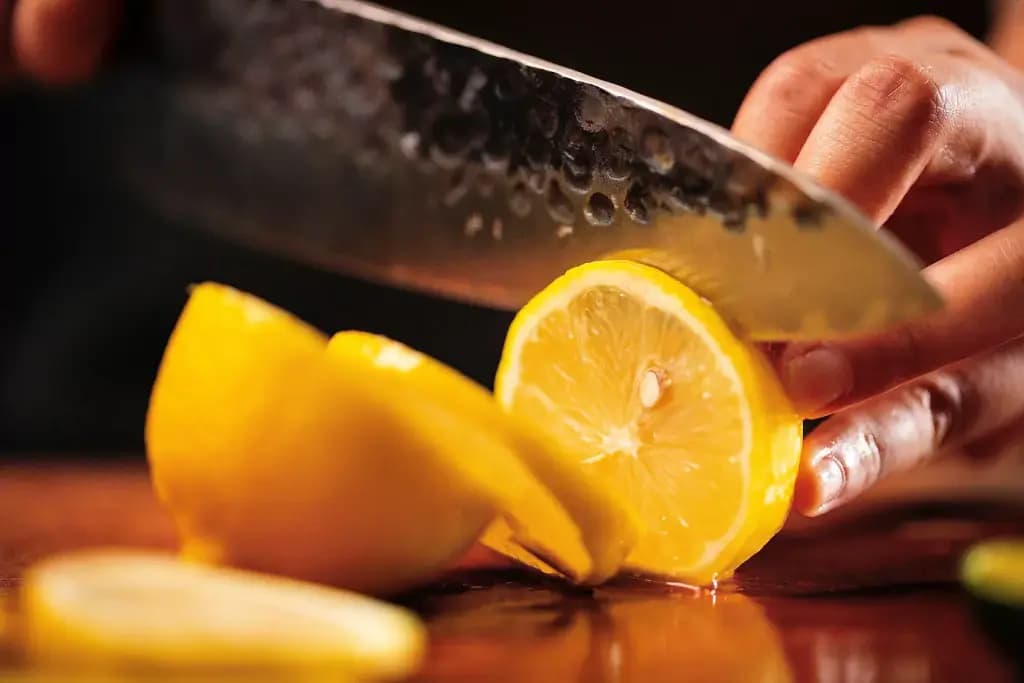

2025 SEPTEMBER 22
.Thuy Fang
Whetstone: An Important Tool for Knife Care!
When you use a knife to cut, each glide through food wears down the blade just a little. Even Japanese knives, famous for their sharpness and high-quality steel, can’t stay perfect forever without proper care. That’s why regularly sharpening your knife with a whetstone is so essential. Let’s take a closer look at this magical kitchen tool!
What is a whetstone?
It’s a special stone made to keep knives super sharp and smooth. It’s a flat, rectangular-shaped block with lots of tiny rough bits on its surface. These little grains work like sandpaper to gently scrape and shape your knife’s edge. Whetstone doesn’t always need oil; it often uses just water. That makes sharpening easier and helps your knife stay clean, strong, and sharp.

Whetstones can be made from natural rocks or created in a factory. Natural ones come from places such as Japan, Belgium, or the USA and are each a little different. Some look so beautiful that collectors keep them as treasures.
On the other hand, synthetic ones are made with materials like aluminum oxide, ceramic, or even diamonds. These man-made stones are reliable as every piece is the same, which helps sharpen your knife steadily and predictably.

Different types of whetstone depend on “grit, ” which tells you how rough or smooth they feel. Coarse stones like 200 to 800 grit help fix damaged knives. Medium stones from 1000 to 3000 grit are excellent for regular sharpening, and fine stones from 4,000 to 8,000 grit polish your knife so it glides like magic.
Some fancy stones even go above 10,000 grit for a shiny mirror-like finish. Many Japanese chefs use three kinds together: ara-to (rough stone), naka-to (middle stone), and shiagea-to (finishing stone) to give their knives the perfect edge.
When was it first invented?
Long ago, before there were factories or machines, people still needed sharp tools to hunt, cook, and build. That’s when whetstones were first used. In fact, some of the oldest ones are believed to date back to 79 AD. However, in Japan, they may go as far back as the Jomon period (14,000–300 BCE), over 10,000 years ago.

In Japan, this tool became especially important. With many kinds of natural rock perfect for sharpening, people used them to care for their tools and swords. During times of war, soldiers relied on sharpened swords, so they became part of everyday life. Over the centuries, Japanese people mastered them. From swordsmiths in the old days to modern chefs today, many people in Japan still use these stones with great care and respect.
Are you looking for great tools to take care of your kitchen knife? Check out ZAKU! ZAKU has authentic knives and accessories handmade in Japan for all of your culinary needs!

What should I look for in a good whetstone?
When choosing a good one, it’s important to think about what you need it for. If your knife is dull or has small chips, you should look for a coarse stone to fix and shape the edge. A fine stone is best if you want your knife to be very sharp and smooth. Some whetstones have two sides to sharpen and polish with just one tool. This makes them very useful in the kitchen.
A good whetstone should feel smooth and steady when you slide the knife across it. It should not break easily or wear down too quickly. Some stones also create a soft, creamy surface while sharpening. This helps make the blade even finer. A stone that works well will help you sharpen safely and clearly.
There are many kinds to choose from. Arkansas stones are strong and last a long time. Japanese stones are gentle and give a beautiful finish. Because natural stones are rare, they are often used with great care.

How should I take care of my whetstone?
Taking care of your whetstone is like looking after a precious tool in your workshop. If you treat it well, it’ll keep your knives sharp for many years. Here are some simple and essential steps to help keep your tool healthy:
Keep it flat: After many uses, the middle of your whetstone can wear down and become uneven. When this happens, you can use a flattening stone or a diamond plate to make it flat again. A flat whetstone helps sharpen your knife more evenly and safely.
Keep it clean: Always rinse your tool with water after sharpening. If there’s dirt or metal dust on it, use a soft brush. This keeps the surface clear and ready for the next use. If yours feels slippery or clogged, gently rub it with another stone or a dressing stone to restore its rough surface.
Don’t soak it too much: Some whetstones need to be soaked before use, while others do not. You can test yours by dipping it in water. If lots of bubbles come out, it is likely to be soaked. If not, just sprinkle a bit of water on top before using. Soaking the wrong kind for too long can weaken or cause it to crack.
What should I do after cleaning it?
Store it safely: After sharpening, dry your tool well. Never leave it wet, as this can lead to cracks. Store it in a cool, dark place away from sunlight, heat, or moisture. If you have more than one whetstone, keep them side by side (not stacked) so they don’t break from the pressure.
Use it gently and the right way: Only sharpen kitchen knives or similar tools. A whetstone on big or damaged tools can wear it down too fast. Also, be careful with your sharpening angle! If it’s too low or too high, it can damage both the knife and the stone. With patience and practice, you’ll get the perfect angle every time.

Why should I not use a honing rod?
Using a honing rod might seem like a quick fix, but it doesn’t actually sharpen your knife; it only slightly straightens the edge. Over time, the blade still becomes dull, especially if you use your knife often. A whetstone gently removes a small metal layer to shape a clean, new edge.
This way, the knife becomes sharp again in a proper and lasting way. So if you love your knife and want to keep it sharp and safe, using a whetstone is a softer and more thoughtful choice. What tool do you use to keep your knife sharp? Have you ever tried a whetstone before? Let me know in the comments!


















